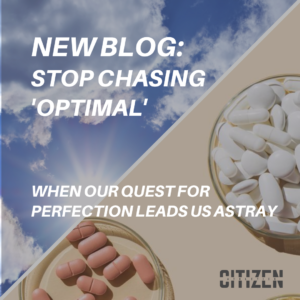As a Physical Therapist, I am commonly tasked with tip-toeing around clients excitement around the latest fitness fads and trends. Often promising a health-haven of fitness and wellbeing, these trends and viral ‘optimization methods’ somehow also defy basic scientific laws.
Many are often harmless and end up resulting in a good laugh every now and then, but none have been more shocking than the ‘bio-hacking’ era many of us have fallen prey to.
Let’s take a real-life case example from a client I worked with a few weeks back. As an eager fitness enthusiast, this individual was confused and struggling to make the progress they had expected in the gym. They were convinced they had it all figured out! How could they possibly not be improving with 4-5 days of quality training per week?!
This individual came to me feeling lost and defeated, however, after asking about their day to day lifestyle and activities, the answer became increasingly obvious… You tell me if you can figure it out:
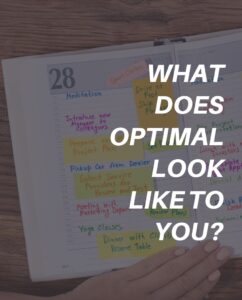 ‘6:40am: Alarm
‘6:40am: Alarm
6:45am: Supplementation & Sun Light Exposure
7:00am: Drive to Gym
7:15-8:15am: Gym Split w/ Meticulous Documentation of Each set
8:15am: Cold Shower
8:30am: Drive to Work
9:00am-12:00pm: Desk Job with Standing Desk that Changes Position Every 30 Mins
12:00-12:45pm: Lunch & More Supplementation
12:45-12:55pm: Restroom (Not Kidding)
1:00-5:00pm: Desk Job with Standing Desk that Changes every 30 Mins…’
… You get the picture.
Militant about maximizing each second in their day, this client was doing everything possible to ‘optimize’ their daily routine.
Now, before we jump on the bandwagon to giggle and point fingers, lets give some context. This individual was struggling to maintain their body size, which had been a personal goal for years. Adding insult to injury, their numbers in the gym seemed to be on a down-turn, despite their meticulous supplementation and high training intensity. They became frustrated & confused that their training status and training commitment didn’t seem to match.
Poking, prodding and assessing further, the real issues began to float to the surface.

This client struggled maintaining a healthy lifestyle involving socialization and spending quality time with others. Instead of carving out time to spend with loved ones, their entire focus was spent on optimizing their nutrition, exercise habits and daily routine.
YUP. THAT STUFF MATTERS TOO
Believe it or not, who we spend our time with and how often we’re able to do so MATTERS when it comes to the fields of stress science, and ‘neurophysiologic’ (aka Brain + Body) recovery. A recent review from Vitale and Smith (2022) addressed factors like cortisol (aka – the ‘stress’ hormone) production, dopamine production, brain activity & size, and ‘endogenous opioid production’ (yeah, your brain makes drugs too) as a product of social isolation, and boy oh boy, the results are a doozy.
We’ll spare you the silly science jargon and cut straight to the chase: If you’re not socializing frequently enough, your brain & body are left to suffer.
- You pee out more cortisol (meaning there’s more of it in your body), a hormone known to alter your stress-response and ability to recover from physically strenuous events (ie training)
- Your brain activity in the Limbic Network (emotional processing) is impacted
- Your body’s ability to produce Dopamine and Endogenous Opioids (aka ‘The Good Stuff’) is significantly disrupted
The problem wasn’t their habits, it was their expectation of what ‘optimal’ looked like.
Lesson 1:
YOUR BODY IS ALREADY OPTIMIZED SO THAT YOUR TRAINING AND LIFESTYLE DON’T HAVE TO BE
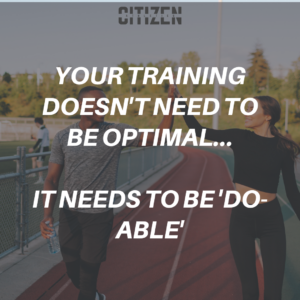 After all, how ‘optimal’ are you really if you need a 2 hour morning routine just to function throughout your day? Wouldn’t ‘optimal’ be just rolling out of bed ready to go? Sure, there’s ways that you can become more efficient with how you ‘recover’, but where do you draw the line?
After all, how ‘optimal’ are you really if you need a 2 hour morning routine just to function throughout your day? Wouldn’t ‘optimal’ be just rolling out of bed ready to go? Sure, there’s ways that you can become more efficient with how you ‘recover’, but where do you draw the line?
Spectrums exist for a reason. As individuals, we all need different levels, intensities, and dosages of activity to maintain the lifestyles we enjoy. Unfortunately, what this client wanted and what their body tolerated were on completely opposite ends of the ‘exercise intensity spectrum’.
We had to pull the reins a bit.
“Take a look back to your newbie lifter days.” I told this client. “Remember how you could add muscle and skyrocket your numbers in the gym, just by doing stuff you saw on IG?? How was your daily routine back then?”
“Nonexistent.” They replied. “I literally was sleeping maybe 5 hours a night, eating cereal for half my meals, and I was hungover for like half of my sessions…”
Lesson 2:
YOUR OUTCOMES CAN BE INSANELY GOOD EVEN IF YOUR TRAINING & LIFESTYLE ARE ‘SUB-OPTIMAL.’

This client could have written a book on ‘What NOT To Do As A Newbie Lifter.’ But they STILL added muscle, lost fat, and PR’d all of their major lifts over their first year of training. So… What was the difference?
Perspective.
Many of us view ‘Optimal’ as a flow state, where exercise, performance, and recovery are conducted in beautiful harmony together. ‘Optimal’ paints the picture of a training utopia where protein powder travels like pollen through the air, fertilizing the trees that sprout PR’s. Training sessions are always productive and your calves finally start to grow!
Shit, I’m daydreaming again aren’t I? Okay, back to reality.
Like many standards in the fitness industry, the term ‘optimal’ paints an unrealistic and often unsubstantiated view of how our training ‘ought’ to be. In reality, ‘Optimal’ is the state where YOU feel your best and prepared to take on the challenges that you find meaningful. It just so happens that as new lifters, our bandwidth for ‘optimal’ is SUPER wide.
At Citizen Athletics, we still believe ‘optimal’ to be a training utopia. But, we see it as an active journey, where consistency, effort, and reinforcement champion your gains in the gym. So, what’s the difference? What if we liked the daydream of calf growth and PR abundance? Why do we need to shift our perspective?
Well…
Lesson 3:
SOME DAYS YOU’RE GOING TO WAKE UP AND JUST FEEL LIKE SH*T.

You overslept your alarm, missed your ride, AND stained your favorite shirt; sometimes you just have to accept you’re having ‘one of those days’.
Let’s be brutally honest here. Your life isn’t ‘optimal.’ And that’s okay! Unless we’re nearing some record setting speed, strength, or performance numbers, our exercise doesn’t need ‘optimization;’ it needs consistency.
Want an even bigger bruise to your ego? Your body has no clue whether you PR’d your back squat, or failed at 80%! All it knows is that there was a heavy-ass stimulus applied to your body, and it should probably start building more bone & muscle tissue if it wants to keep up with your daily gym antics.
Rather than focusing on hitting your top end numbers for every set, what if you tried anchoring your body to a level of perceived fatigue, or exertion (aka RPE)? If we can understand & appreciate that all we’re trying to do with exercise is apply a specific stimulus (ie heavy squat) to facilitate a general adaptation (muscular strength), then we’re able to free ourselves from the shackles of ‘optimized training.’ Let’s be honest, we rarely finish every session anyway, might as well focus on the things we care about.
A distance runner doesn’t expect to go out and run a marathon every time they run, so why are you expecting to crush your PR’s every time you walk into the gym?
Lesson 4:
IF ALL DAYS ARE HARD, NO DAYS ARE HARD.
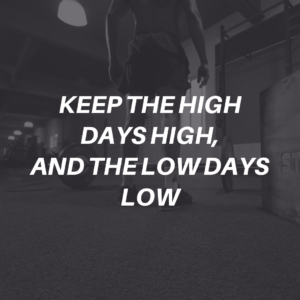
Expecting to give it 100% every time you walk into the gym is an error we all make in our exercise careers. We just hope you can learn it earlier than we did.
The truth is, we NEED low intensity days to help facilitate recovery and allow our bodies to adapt to previous exercise stimuli. Low intensity or ‘sub-max’ days are a great way that you can work on ‘raising the floor’ (ie – bringing up your daily minimums) rather than constantly banging your head into the ‘ceiling’ (ie – increase your 1RM).
(Fun Fact: the Minimal Effective Dose – aka the least you can do and still make gains – is actually pretty low if you’re an intermediate lifter! Check it out here.)
Trying to hit a PR on Monday will probably leave you pretty taxed until Wednesday or Thursday; so make sure your ‘optimal’ exercise plan factors that in! Yes, our bodies are pretty freaking incredible, but they’re not machines (that’s a good thing). They ADAPT to the loads that you place on them, so make sure you give them a ‘good enough’ environment to do so.
If you’re struggling with managing your own programming, or want more ‘deep dive’ content like this, the Citizen Athletics app is the perfect entry point into science-backed training from trusted Physical Therapists & Coaches with years of education & experience in the field; all at your fingertips.
Click here to sign up today.
ABOUT THE AUTHOR:
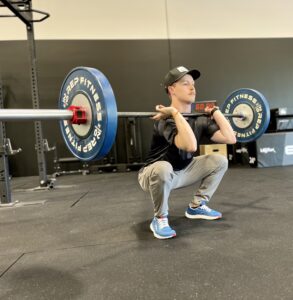
Dylan Carmody is a Doctor of Physical Therapy, and Strength & Conditioning Coach with 5+ years in the performance and rehab industries.
Having dabbled in training modalities like Olympic Lifting, Cycling, Powerlifting, and CrossFit, Dylan has a deep appreciation for all things performance, while still having a positive and fun-loving approach to exercise.
Dylan’s coaching experience is equally eclectic, ranging from performance coaching for elite athletes in the NCAA D1 setting, to group fitness and weight loss coaching in his early career.
With detailed exercise programming & consistent communication, he aims to create a training environment that is not only ‘tolerable’ for clients’ aches and pains, but truly helps to resolve their issues in the first place.
Sources:
- Androulakis-Korakakis, Patroklos et al. “The Minimum Effective Training Dose Required for 1RM Strength in Powerlifters.” Frontiers in sports and active living vol. 3 713655. 30 Aug. 2021, doi:10.3389/fspor.2021.713655
- Vitale, Erika M, and Adam S Smith. “Neurobiology of Loneliness, Isolation, and Loss: Integrating Human and Animal Perspectives.” Frontiers in behavioral neuroscience vol. 16 846315. 8 Apr. 2022, doi:10.3389/fnbeh.2022.846315


